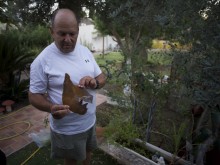Washington Post Ventures from Gaza to Cover Israel

News coverage of Operation Protective Edge mainly focused on casualties in the Gaza Strip, missiles launched at Israel and tunnels built by Hamas. There was comparatively little attention to the lives and hardships of Israelis, especially those who resided close to Gaza. So The Washington Post’s feature “I want to come back but, I’m afraid” (Aug. 14, 2014) was a noteworthy gesture toward balance.
The article commented that “[f[or the past month, ‘frontline communities’ such as Nahal Oz and a neighboring kibbutz, Kfar Aza, resembled ghost towns. Most residents fled what had become a combat zone, with Israeli artillery whooshing above them and Gaza rockets flying the other way, sometimes landing on rooftops or in gardens and schoolhouses.”
After Hamas took over the Gaza Strip in 2006, the southern Israeli town of Sderot and nearby kibbutzim have endured a rain of mortars and rockets that was under-reported by news media. Despite Israel’s complete withdrawal from Gaza in 2005, Palestinian complaints of “Israeli occupation” and Israel’s “siege” (a partial blockade aimed at limiting importation of material useful to Hamas and other terrorist groups) tended to draw the bulk of news reporting.
Without better balanced coverage, audiences don’t learn what life has been like on the Israeli side of the armistice line or the reasons for military operations conducted by Israel. (CAMERA has noted previous examples of more comprehensive coverage such as “Exhibit A: USA Today’s Well-Balanced Gaza Reporting”, July 15, 2014).
The Post ’s feature helped make real to readers the experiences of Israelis near Gaza. “People are so tired of living as refugees in their own country,” said Noam Stahl, 47, a plastics consultant and resident of Kfar Aza who was born and raised in the kibbutz.
The Post showed how Palestinian terror attacks affected the residents of Israel’s south wherever they were in their own country:
“Residents patiently answer questions about why they don’t move somewhere safer, as if it were so obvious it needs no explanation. Where in Israel is safe?
“‘In Tel Aviv, five years ago, people were afraid if they got on a bus it would explode,’ Stahl said. ‘Jerusalem was the same. At Kiryat Shmona in the north, for 15 years they had Katyusha rockets come at them from Lebanon. If I decide it’s no longer safe to live here, if I take my family and move elsewhere in Israel, who can guarantee we won’t be the target of a terrorist attack in our new home?’”
Stahl depicts Israel’s situation as it is. Israel bashers sometimes falsely describe the Gaza Strip as an “open air prison”. Such loaded language would not accurately describe Israel but the Jewish State is surrounded by countries and terrorist groups who have been seeking its destruction and since its inception in 1948. Perhaps more media attention to this enduring hostility and its effects on Israelis, less uncritical attention to Palestinian grievances and claims of Israeli oppression would help readers understand the conflict.
The Post’s “I want to comeback, but I’m afraid,” accurately described the situation for many residents of southern Israel . In doing so it informed readers of another side to the Arab-Israeli conflict—better, the Arab-Islamic conflict with Israel—too little discussed: the impact on Israelis. Other media outlets should take note. — Ziv Kaufman
More from SNAPSHOTS
Professor John Quigley Falsely Condemns Israel and U.S. Support in His Syndicated Column
April 30, 2019
John B. Quigley In his widely distributed April syndicated opinion piece mainly about ISIS, the Islamist terrorist entity, John B. Quigley, an Ohio State University law professor, argues that claims of an imminent ISIS resurgence [...]
The New York Times’ Slow Reaction to Hamas Crackdown on Palestinian Protesters
April 4, 2019
The New York Times took a slight jab at Hamas, the terrorist organization that rules the Gaza Strip, in a recent story about Hamas's crackdown on Palestinian protesters who spoke out against its policies in [...]
CNN’s Zakaria Deals With U.S. Proclamation Recognizing Golan As Part Of Israel
April 3, 2019
Fareed Zakaria hosted an eight-minute discussion of the Golan matter at the end of his weekly (weekend) program, “Global Public Square “ (GPS) hour-long Cable News Network (CNN) broadcast. The broadcast, on both CNN and [...]
NY Times Reporter David Halbfinger Editorializes Israel as “Brutal”
March 6, 2019
New York Times Jerusalem bureau chief David Halbfinger Israel, according to the New York Times, is a brute. A March 3 news analysis piece—not an opinion piece—by the newspaper's Jerusalem bureau chief David Halbfinger uses [...]
Palestinian Malevolent Indoctrination Exposed; Mainstream Media Are Indifferent
February 26, 2019
Palestinian Media Watch (PMW), an Israel-based non-governmental organization, analyzes and presents in English to the world the ongoing inflammatory indoctrination of Palestinians in Arabic particularly via Palestinian Authority (PA) television (West Bank). PMW is a [...]
Did WCC Activists Attend A Birthday Party Promoted by Palestinian Extremist Organization?
February 4, 2019
The video is a bit fuzzy and grainy. But the footage of birthday party for Shadi Farar, a 12-year-old Palestinian boy who spent three years in an Israeli jail on charges of intent to murder, [...]
Reuters Falsely Links Jerusalem Embassy, Two-State Solution
January 9, 2019
The Jerusalem office park which houses Guatemala's embassy Multiple recent Reuters articles incorrectly report that moving the Brazilian embassy from Tel Aviv to Jerusalem is a dramatic move away from the two-state solution. For instance, [...]


